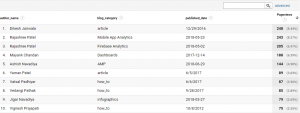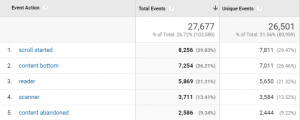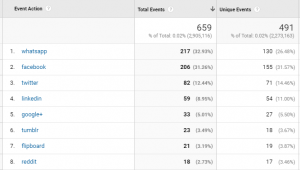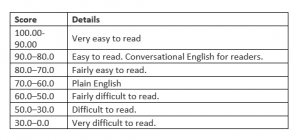For digital publishers, generating steady revenue from a set of consistent sources has been a long-standing pain point. So, many content-driven websites have bitten the dust owing to the absence of a steady revenue stream against the heavy operational costs. A few most common revenue-generating sources for digital publishers are Advertisements. Now, in today’s world of data analytics, I am sure you have your Google Analytics all set up with the right set of goals and events firing, giving you a snapshot of how your website is performing.
But have you ever thought about how you can make the most of the data you are collecting on your Google Analytics by using it to generate revenue in ways more than you can imagine? With this article, I am going to guide you on how to build a comprehensive strategy so that you can monetize your content based on its performance using Google Analytics 360. There are seven things an editor of a Digital Publisher should track in Google Analytics for effective content strategy and monetization.

If you know your audience you can tailor your content strategy appropriately. You can also leverage that data to secure the ever-so-crucial advertising dollars necessary to keep your lights on. Some of the following solutions would help us make quick decisions about content, users, events, and sources.
Custom Solutions and Analysis, Must Track Interactions:
In this blog, we will talk about custom solutions that you can easily implement in Google Analytics with some of the use cases intended to help your team to understand and achieve the business objectives.
1. Meta Data of Articles
Publication Date and Publication Month: Publication date and month helps to understand the duration wise fluctuation in interests of the audience. With the web growing exponentially the interests vary to a wider range. This is influenced by demographics.
Taking an example, in the days preceding the Super Bowl, there are presumptions on the line ups to field and there is hype in the US audience. When the publisher is in a region where there are various events, dates pose significance in the analysis. Dates and Month will act as benchmarks for your preparation for future events basis the historical data.
Publication Year: 2011 the year of cricket world cup rings a bell to every Indian; the significance of the year is paramount. Publication year helps in recollecting events as well as analyzing the trend.
Author Name: Publisher houses ought to know, who their best-performing authors are. This will help them in giving a greater role and marketing their content. The authors carry their own audience irrespective of the publisher. The fame of the author needs to be used to garner more audience.
Article Category: Every individual has an affinity towards a particular genre. The best performing genres will help in deciding the upcoming content.
Article Tags: There is a nice group of article category that specializes in various arts. Tagging articles help easy recognition by the reader.
Use Case:
 Image 1: Meta Data Report in Google Analytics
Image 1: Meta Data Report in Google Analytics
The above image is of the Google Analytics report which helps us understand how these metadata can be used to derive insights like top 10 authors/top 10 blog categories garnering the most page views in a given time period, etc.
2. Reader Scanner Analysis
This implementation is mainly for content-based websites. e.g. blogs, digital news sites, etc. to get insights on which content is getting which type of attention.
For Example: On a publisher website with a good volume of visitors, some will come, read the article and go while others might just scan the page, will not do a major activity. In this case, if we can analyze the type of user based on reader scanner key which can be either time spend on the page during scrolling down.
- Retarget the engaged audience that is actually reading a particular set of articles and based on this data, content personalization and recommendation of other similar articles can also be done.
- Build a strategy that is data-driven, for those users that are falling into the scanner category. For example, we can run a recommendation for these users based on the user persona and can improve engagement KPI’s.

Image 2: Reader vs. Scanner Report in Google Analytics
The above report explains the interaction in five categories. With this report, we will be able to understand what are the total events where scrolling has started. It will also help us understand the total interaction for bottom content indicating whether the user read through the content or simply scanned his way to the end of it.
3. Ad-blocker Tracking
Currently, there are plenty of add-ons that specialize in blocking ad pop-ups and ads. Unless tracked properly, one will lose revenue monetized from ads. Even avid engaged readers often utilize these add-ons and the ad-blocker tracking in Google Analytics will help you find ways to circumvent the stoppage or request the readers to stop using them if they want to continue to read.
 Image 3: AdBlocker Tracking Report in Google Analytics
Image 3: AdBlocker Tracking Report in Google Analytics
Ad-Blocker Use-case:
- Find out missing revenue: The approximated revenue being lost for the usage of Ad-Blocks by the readers in your sites/blogs. This statistical figure gives you an indicator of the growth figure you are losing out. Decisions can be taken, to minimize these issues and revenue growth can be taken care of without any addition to the reader base.
- Non-paying user’s percentage using ad-blockers: The statistics can also give you a skewed perspective about the increase in reader base which may not translate into revenue. Although it is an acceptable approach that increase in readership base increases your revenue. But one of the many reasons for the same can be that your audience percentage pie of the total audience has moved to the usage of ad blockers. This additional drill-down will give you an additional decision making power in overcoming this issue.
4. Article Share Tracking
In the reign of Social Media, shares help you reach a wider audience. A number of shares are directly proportional to the reach or the number of people who have viewed your content. Each share acts as a node and helps in dissipating to more audience. This is not a linear growth and you know as well as I do that, it is an opportunity for achieving exponential growth in content consumption.
 Image 4: Social Sharing of Article Report in Google Analytics
Image 4: Social Sharing of Article Report in Google Analytics
You can find a lot of original content that originated on social media. Publishers have achieved success there faster than on any other medium. Article share tracking is done by the event tracking mechanism, which also helps to measure the virality of their content.
Article sharing report helps to decide the genre of content to be published in the future and understanding the expectations of your audience.
5. Word Count
Publishers ought to think about the word count of their different content available on their website. There is a strong correlation between the engagement and the word count. Many publishers base their articles on the criterion of industry-related SEO data. They often use these parameters in deciding the word count and the content for engaged readership.
Just the way any vehicle’s efficiency is measured by the factor called ‘RPM’, the same logic can be borrowed for publishers. ‘RPM’ or Revenue per Thousand Impressions can be a useful metric in gauging the worthiness of the website. In turn, the RPM depends on multiple input parameters such as word count, page performance (better landing page gives a compulsion the users to read more articles).
To give a brief overview, longer content will have more word count; this increases the stress to the reader. An optimum word count is measured using RPM when a publisher wants to increase the revenue without affecting the user count.
6. Readability Score
Readability is the ease with which your readers are able to read through your content. Most readers gauge the quality of articles by simply scanning it first and it is painstaking for the users to read word by word the whole articles due to a paucity of time.
We implement a readability score based on Flesch-Kincaid readability tests designed to show how easy or difficult a text is to read. The chart below gives us an idea of what readability score means what:
 Readability score as a dimension can be added with other metadata. This will enable publishers to extract insights like what is the best readability score for which type of article, by which author, on which topic.
Readability score as a dimension can be added with other metadata. This will enable publishers to extract insights like what is the best readability score for which type of article, by which author, on which topic.
7. Predict Virality Index
Virality index solution is an internal solution for Digital Publishers. This solution uses a Machine Learning algorithm to predict which published articles will go viral or popular by forecasting which articles have a higher potential to bring in maximum page views.
Benefits:
1. Predict Virality of Articles: Tatvic’s Article Virality Predictor classifies the articles which will go viral; draw major page views to the article or high volume of readers.
2. Optimize Advertising boost spend: Know which articles to boost on GDN/Social Media and which not to, thereby optimizing ad spend.
3. Increase Publisher Revenue: With the boosting of viral articles, increase publisher revenue from well-targeted ads on the articles pages for a high volume of readers.
4. Publish Viral Category Content: Rank your high page views generating article categories and publish more articles on these categories
Pre-requisites:
- GA 360 Account or GA Standard Account
- Big Query Service Account Access (Optional)
- Article Feed Data (Content, Language, Title, Length, Author Name, Published Date and Time, Keywords)
- Custom variables tracking (Social Shares, Scroll Depth)
Concluding Thoughts
Looking to the future which is clearly more data-oriented, there is no space to take any decision on hunches. Data Analytics will give you in-depth insights and statistics determining what your audience is engaging within your site.
With custom solutions described here and the likes of them as well, we are better equipped to understand our reader persona and it can also be utilized to recommend a topic which a user is interested to read. If you have encountered the same scenarios where you feel hapless, do share your views in the comments. Happy reading and analyzing.
Article source: https://martechseries.com/mts-insights/guest-authors/custom-solution-publishers-should-be-tracking-in-google-analytics/
